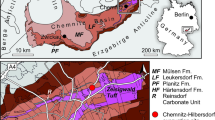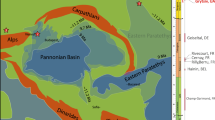Abstract
An isolated mandible of a large temnospondyl from Theisbergstegen, Rhineland-Palatinate, is described that is derived from the Late Carboniferous Remigiusberg Formation of the Saar-Nahe Basin, southwestern Germany. The mandible is well preserved and exposed in lingual view, showing typical characteristics of basal eryopoids (i.e., eryopids plus stereospondylomorphs) such as the small size of the postglenoid area formed by the surangular and articular and the rather small Meckelian fenestra that fails to contact the postsplenial. It can be distinguished from the mandibles of all other known eryopoids from the Saar-Nahe Basin by characters such as a distinctly higher surangular process, higher, more strongly curved marginal teeth and the presence of a symphyseal lamina with at least one large parasymphyseal tooth. The mandible resembles those of eryopids rather than stereospondylomorphs in the angle of jaw being located on the level of the anterior portion of the surangular process and the dorsal edge of the mandibular ramus being dorsally concave. The described mandible is unequivocally the earliest known eryopoid from the Saar-Nahe Basin and shows that also large temnospondyls invaded the lakes of the Saar-Nahe Basin already during the “Remigiusberg invasion” in the Late Carboniferous.
Kurzfassung
Ein isolierter Unterkiefer eines großen Temnospondylen aus Theisbergstegen, Rheinland-Pfalz, wird beschrieben, welcher aus der Remigiusberg-Formation (spätes Karbon) des Saar-Nahe Beckens in Südwest-Deutschland stammt. Der Unterkiefer ist sehr gut in lingualer Ansicht erhalten und zeigt typische Merkmale der basalen Eryopoidea (d.h. Eryopidae plus Stereospondylomorpha), wie beispielsweise die geringe Größe der Postglenoid-Fläche, die durch das Surangulare und Artikulare gebildet wird, sowie das eher kleine Meckelsche Fenster, welches das Postspleniale nicht erreicht. Der Unterkiefer kann von denjenigen aller bekannten Eryopoiden des Saar-Nahe Beckens unterscheiden werden durch Merkmale wie den deutlich höheren Surangularfortsatz, höhere, stärker gebogene marginale Zähne sowie das Vorhandensein einer symphysealen Lamina mit mindestens einem großen Parasymphysenzahn. Der Unterkiefer erinnert eher an Vertreter der Eryopidae als an Vertreter der Stereospondylomorpha, da der Kieferwinkel auf der Höhe des anterioren Teils des Surangular-Fortsatzes liegt und die dorsale Grenze des Unterkieferastes dorsal konkav ist. Der beschriebene Unterkiefer ist unzweifelhaft der früheste bekannte Nachweis eines Eryopoiden im Saar-Nahe Becken und zeigt, dass auch große Temnospondylen die Seen des Saar-Nahe Beckens schon während der “Remigiusberg-Invasion” im späten Karbon besiedelten.





Similar content being viewed by others
References
Ahlberg, P.E., and J.A. Clack. 1998. Lower jaws, lower tetrapods—A review based on the Devonian genus Acanthostega. Transactions of the Royal Society of Edinburgh: Earth Sciences 89: 11–46.
Boy, J.A. 1972. Die Branchiosaurier (Amphibia) des saarpfälzischen Rotliegenden (Unter-Perm, SW-Deutschland). Abhandlungen des Hessischen Landesamtes für Bodenforschung 65: 1–137.
Boy, J.A. 1988. Über einige Vertreter der Eryopoidea (Amphibia: Temnospondyli) aus dem europäischen Rotliegend (?höchstes Karbon—Perm). 1. Sclerocephalus. Paläontologische Zeitschrift 62: 107–132.
Boy, J.A. 1989. Über einige Vertreter der Eryopoidea (Amphibia: Temnospondyli) aus dem europäischen Rotliegend (?höchstes Karbon—Perm). 2. Acanthostomatops. Paläontologische Zeitschrift 63: 133–151.
Boy, J.A. 1990. Über einige Vertreter der Eryopoidea (Amphibia: Temnospondyli) aus dem europäischen Rotliegend (?höchstes Karbon—Perm). 3. Onchiodon. Paläontologische Zeitschrift 64: 287–312.
Boy, J.A. 1993. Über einige Vertreter der Eryopoidea (Amphibia: Temnospondyli) aus dem europäischen Rotliegend (?höchstes Karbon—Perm). 4. Cheliderpeton latirostre. Paläontologische Zeitschrift 67: 123–143.
Boy, J.A. 1996. Ein neuer Eryopoide (Amphibia: Temnospondyli) aus dem saarpfälzischen Rotliegend (Unter-Perm, Südwest-Deutschland). Mainzer Geowissenschaftliche Mitteilungen 25: 7–26.
Boy, J.A., and T. Schindler. 2000. Ökostratigraphische Bioevents im Grenzbereich Stephanium/Autunium (höchstes Karbon) des Saar-Nahe-Beckens (SW-Deutschland) und benachbarter Gebiete. Neues Jahrbuch für Geologie und Paläontologie Abhandlungen 216: 89–152.
Boy, J.A., and H.-D. Sues. 2000. Branchiosaurs: Larvae, metamorphosis and heterochrony in temnospondyls and seymouriamorphs. In Amphibian Biology, ed. R.L. Carroll, and H. Heatwole, 1150–1197. Chipping Norton, Australia: Surrey Beatty & Sons PTY Limited.
Burger, K., J.C. Hess, and H.J. Lippolt. 1997. Tephrochronologie mit Kaolin-Kohlensteinen: Mittel zur Korrelation paralischer und limnischer Ablagerungen des Oberkarbons. Geologisches Jahrbuch A 147: 3–39.
Fröbisch, J., R.R. Schoch, J. Müller, T. Schindler, and D. Schweiss. 2011. A new basal sphenacodontid synapsid from the Late Carboniferous of the Saar-Nahe Basin, Germany. Acta Palaeontologica Polonica 56: 113–120.
Gubin, Y.M. 1991. Permian archegosauroid amphibians of the USSR. Trudy Paleontologichesko Instituta Nauka SSSR 249: 1–138. [in Russian].
Königer, S., V. Lorenz, H. Stollhofen, and R.A. Armstrong. 2002. Origin, age and stratigraphic significance of distal fallout ash tuffs from the Carboniferous-Permian continental Saar-Nahe Basin (SW Germany). International Journal of Earth Sciences (Geologische Rundschau) 91: 341–356.
Konzhukova, E.D. 1956. [The Intan Lower Permian fauna of the northern Ural region]. Trudy Paleontologiceskogo Instituta Akademiya Nauk SSSR 62: 5–50 (in Russian).
Laurin, M., and R. Soler-Gijón. 2006. The oldest known stegocephalian (Sarcopterygii: Temnospondyli) from Spain. Journal of Vertebrate Paleontology 26: 284–299.
Lippolt, H.J., and J.C. Hess. 1989. Isotopic evidence for the stratigraphic position of the Saar-Nahe-Rotliegende volcanism. III. Synthesis of results and geological implications. Neues Jahrbuch für Geologie und Paläontologie Monatshefte 1989(9): 553–559.
Lucas, S.G., L.F. Rinehart, and A.P. Hunt. 2005. Eryops (Amphibia, Temnospondyli) from the Upper Pennsylvanian of El Cobre Canyon, New Mexico. New Mexico Museum of Natural History and Science Bulletin 31: 118–120.
Menning, M., D. Weyer, G. Drozdzewski, H.W.J. van Amerom, and J. Wendt. 2000. A Carboniferous time scale 2000: discussion and use of geological parameters as time indicators from central and Western Europe. Geologisches Jahrbuch A 156: 3–44.
Milner, A.R. 1990. The radiations of temnospondyl amphibians. In Major evolutionary radiations, ed. P.D. Taylor, and G.P. Larwood, 321–349. Oxford: Clarendon Press.
Milner, A.R., and S.E.K. Sequeira. 1993. The temnospondyl amphibians from the Viséan of East Kirkton, West Lothian, Scotland. Transcations of the Royal Society of Edinburgh Earth Sciences 84: 331–361.
Miner, R.W. 1925. The pectoral limb of Eryops and other primitive tetrapods. Bulletin of the American Museum of Natural History 51: 145–312.
Pawley, K., and A.A. Warren. 2006. The appendicular skeleton of Eryops megalocephalus Cope, 1877 (Temnospondyli: Eryopoidea) from the Lower Permian of North America. Journal of Paleontology 80: 561–580.
Ruta, M., M.I. Coates, and D.L.J. Quicke. 2003. Early tetrapod relationships revisited. Biological Reviews 78: 251–345.
Sawin, H.J. 1941. The cranial anatomy of Eryops megacephalus. Bulletin of the Museum of Comparative Zoology Harvard University 88: 407–463.
Schoch, R.R. 1999. Comparative osteology of Mastodonsaurus giganteus (Jaeger 1828) from the Middle Triassic (Lettenkeuper: Longobardian) of Germany (Baden-Württemberg, Bayern, Thüringen). Stuttgarter Beiträge zur Naturkunde Serie B (Geologie und Paläontologie) 278: 1–175.
Schoch, R.R. 2003. Early larval ontogeny of the Permo-Carboniferous temnospondyl Sclerocephalus. Palaeontology 46: 1055–1072.
Schoch, R.R. 2009. Evolution of life cycles in early amphibians. Annual Review of Earth and Planetary Sciences 37: 135–162.
Schoch, R.R., and A.R. Milner. 2000. Stereospondyli. In Handbuch der Paläoherpetologie, vol. 3, ed. P. Wellnhofer, 1–200. München: Verlag Dr. Friedrich Pfeil.
Schoch, R.R., and O. Hampe. 2004. An eryopid-like temnospondyl from the Lower Rotliegend Meisenheim Formation of the Saar-Nahe Basin. Neues Jahrbuch für Geologie und Paläontologie Abhandlungen 232: 315–323.
Schoch, R.R., and B.S. Rubidge. 2005. The amphibamid Micropholis stowi from the Lystrosaurus assemblage zone of South Africa. Journal of Vertebrate Paleontology 25: 502–522.
Schoch, R.R., and F. Witzmann. 2009a. Osteology and relationships of the temnospondyl genus Sclerocephalus. Zoological Journal of the Linnean Society London 157: 135–168.
Schoch, R.R., and F. Witzmann. 2009b. The temnospondyl Glanochthon from the Lower Permian Meisenheim Formation of Germany. Special Papers in Palaeontology 81: 121–136.
Sequeira, S.E.K. 2004. The skull of Cochleosaurus bohemicus Frič, a temnospondyl from the Czech Republic (Upper Carboniferous) and cochleosaurid interrelationships. Transactions of the Royal Society of Edinburgh Earth Sciences 94: 21–43.
Swofford, D.L. 2003. PAUP*: phylogenetic analysis using parsimony (*and other methods). Version 4. Sunderland, MA: Sinauer Associates.
von Ammon, L. 1889. Die permischen Amphibien der Rheinpfalz. München: Verlag F. Straub.
von Meyer, H. 1860. Osteophorus römeri aus dem Rothliegenden von Klein-Neundorf in Schlesien. Palaeontographica 7: 99–104.
Werneburg, R. 1993. Onchiodon (Eryopidae, Amphibia) aus dem Rotliegend des Innersudetischen Beckens. Paläontologische Zeitschrift 67: 343–355.
Werneburg, R. 1997. Der Eryopide Onchiodon (Amphibia) aus dem Rotliegend des beckens von Autun (Frankreich). Freiberger Forschungshefte C 466: 167–181.
Werneburg, R. 2007. Der “Manebacher Saurier”—ein neuer großer Eryopide (Onchiodon) aus dem Rotliegend (Unter-Perm) des Thüringer Waldes. Veröffentlichungen Naturhistorischen Museum Schleusingen 22: 3–40.
Werneburg, R., and J.-S. Steyer. 1999. Redescription of the holotype of Actinodon frossardi (Amphibia, Temnospondyli) from the Lower Rotliegend of the Autun Basin (Lower Permian, France). Geobios 32: 599–607.
Werneburg, R., S.G. Lucas, J.W. Schneider, and L.F. Rinehart. 2010. First Pennsylvanian Eryops (Temnospondyli) and its Permian record from New Mexico. New Mexico Museum of Natural History and Science Bulletin 49: 129–135.
Witzmann, F. 2006. Cranial morphology and ontogeny of the Permo-Carboniferous temnospondyl Archegosaurus decheni Goldfuss, 1847 from the Saar–Nahe Basin, Germany. Transactions of the Royal Society of Edinburgh, Earth Sciences 96: 131–162.
Witzmann, F. 2011. Die Amphibien vom Relsberg- bis zum Klauswald-Horizont. In Ursaurier, Riesenskorpion & Co. Eine spannende Zeitreise in das Erdaltertum, ed. R. Springhorn, 95–104. München: Verlag Dr. Friedrich Pfeil.
Witzmann, F., Schoch, R.R., and Milner, A.R. 2007. The origin of the Dissorophoidea—an alternative perspective. Journal of Vertebrate Paleontology, Supplement 3: 167A.
Yates, A.M., and A.A. Warren. 2000. The phylogeny of the ‘higher’ temnospondyls (Vertebrata: Choanata) and its implications for the monophyly and origins of the Stereospondyli. Zoological Journal of the Linnean Society 128: 77–121.
Acknowledgments
I want to thank Ulrich H.J. Heidtke (Niederkirchen) for drawing my attention to the Remigiusberg mandible and Benno Rahm (Stockborn-Kaiserslautern) for his hospitality and the possibility to study the specimen. David Marjanović is thanked for assistance with the phylogenetic analysis. The reviews of Marcello Ruta and Rainer Schoch have greatly improved the manuscript.
Author information
Authors and Affiliations
Corresponding author
Appendix: Character-taxon matrix: additional characters to Schoch and Witzmann (2009b)
Appendix: Character-taxon matrix: additional characters to Schoch and Witzmann (2009b)
List of taxa:
Ba, Balanerpeton (Milner and Sequeira 1993); Co, Cochleosauru (Sequeira 2004); Mi, Micropholis (Schoch and Rubidge 2005); Ac, Acanthostomatops (Boy 1989); Ib, Iberospondylus (Laurin and Soler-Gijón 2006); Er, Eryops (Sawin 1941); On, Onchiodon (Boy 1990; Werneburg 2007); Rm, Remigiusberg mandible; Sh, Sclerocephalus haeuseri (Schoch and Witzmann 2009a); Ga, Glanochthon angusta (Schoch and Witzmann 2009a); In, Intasuchus (Konzhukova 1956); Ar, Archegosaurus (Witzmann 2006); Pl, Platyoposaurus (Gubin 1991).
Ba | Co | Mi | Ac | Ib | Er | On | Rm | Sh | Ga | In | Ar | Pl | |
|---|---|---|---|---|---|---|---|---|---|---|---|---|---|
55 | 1 | 0 | 0 | 0 | 0 | 0 | 0 | 0 | 0 | 0 | 0 | 0 | 0 |
56 | 1 | 0 | 0 | 0 | 0 | 0 | 0 | 0 | 0 | 0 | 0 | 0 | 0 |
57 | 0 | 1 | 0 | 1 | 0 | 0 | 0 | 0 | 0 | 0 | 0 | 0 | 0 |
58 | 1 | 0 | 0 | 0 | 0 | 0 | 1 | 0 | 0 | 0 | 0 | 0 | 0 |
59 | 1 | 1 | 0 | 0 | 0 | 0 | 1 | 0 | 0 | 0 | 0 | 0 | 0 |
List of characters:
#55, angle of jaw located posterior to the level of the anterior portion of the surangular process (0), or angle of jaw being located on the level of the anterior portion of the surangular process (1) (new character);
#56, dorsal edge of mandibular ramus anterior to the surangular process is dorsally straight (0), or dorsal edge of mandibular ramus anterior to the surangular process is dorsally concave (1);
#57, prearticular does not contact coronoid 1 (0), or prearticular contacts coronoid 1 (1) (new character);
#58, parasymphyseal teeth are not or only slightly smaller than the adjacent marginal teeth (0); parasymphyseal teeth are smaller than the adjacent marginal teeth (1) (new character); no parasymphyseal teeth are present (2) (new character);
#59, posterodorsal process of posterior coronoid not contributing (0) or contributing (1) to tallest point of lateral margin of adductor fossa (surangular process) (character 216 of Ruta et al. 2003).
Rights and permissions
About this article
Cite this article
Witzmann, F. The stratigraphically oldest eryopoid temnospondyl from the Permo-Carboniferous Saar-Nahe Basin, Germany. Paläontol Z 87, 259–267 (2013). https://doi.org/10.1007/s12542-012-0152-2
Received:
Accepted:
Published:
Issue Date:
DOI: https://doi.org/10.1007/s12542-012-0152-2




